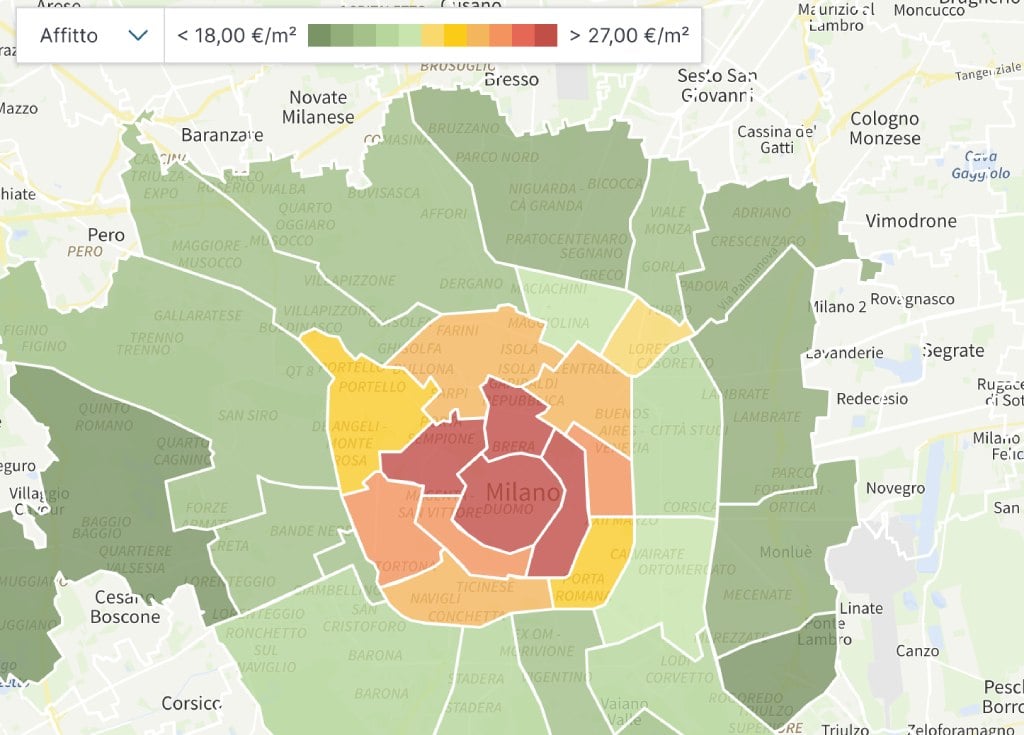With its wealth of job opportunities and international appeal, Milan is one of the most popular Italian cities among foreigners.
The northern economic powerhouse is home to over 475,000 foreign nationals (around 14.7 percent of the city’s total population), including a sizeable group of native English speakers.
But high demand for accommodation, high prices (monthly rent in the city comes at an average of around €25 per square metre – that’s over €12 above national average) and housing shortages all make finding a place to rent a challenging task.
Italian rental contracts
Before actually starting to look for an apartment, it’s generally advisable to get familiar with Italy’s most popular rental agreements, or contratti di affitto in Italian.
Excluding tourist lets (contratti turistici), which range from a minimum of one day to a maximum of 30 days, the shortest available rental agreement is the transitory contract, or contratto di locazione ad uso transitorio.
This lasts a minimum of one month up to a maximum of 18 months, and comes with an important caveat: you’ll need to specify and prove that you have a specific, non-tourism-related reason for your temporary stay, like an apprenticeship, a short-term work contract, or degree program.
If you’re a student attending a university, you may also be able to sign a student contract (contratto di locazione per studenti universitari), which can last between six months and three years.

Finally, if you’re looking for longer-term agreements, you have two main options:
- Unrestricted contract (contratto a canone libero). This lasts for four years, with an automatic option to renew for four more. The rental price is freely set by the landlord.
- Determined contract (contratto a canone concordato). This lasts for three years with an automatic option to renew for two more. Rent in this case is set by the relevant municipality (or comune) and cannot be negotiated.
For further info on both of the above contracts, see our article on the topic.
Regardless of which type of contract you sign, you should always make sure there’s a clause that allows you to move out after a specified notice period (this is usually a full six months).
Using an agency
Once you’re familiar with the types of contracts available, you can start your search.
Milan has plenty of agenzie immobiliari that can help you find your future home, with some specialised in assisting international customers (for instance, Renting Milan).
These agencies will do the work of finding and connecting you with potential properties, and negotiate the terms of the contract on your behalf. They may also know about some properties before they hit the open market, giving you a leg up on the competition.
But there are some downsides too. Properties let through rental agencies can be more expensive, as the owners must cover the costs of their own fees to the agency.
READ ALSO: How much does it cost to live in Milan in 2024?
Further, rental agencies will generally take a commission equivalent to one or two months’ rent from the tenant, which can make initial expenses rise very fast when added to the apartment’s security deposit (usually two months’ rent).
Searching online
If agency fees look a little too steep – or if you just want to explore every option – there’s an increasing number of online rental portals that you can check out.
These sites often offer a mix of properties proposed by rental agencies and apartments rented directly by owners. Some of the most popular ones for renting are Idealista, Immobiliare, Casa and Bakeca.
All work more or less the same way: select your area, filter by cost, number of rooms, and other details, and see what’s available.
Quite conveniently, some of these websites feature maps showing statistics on rental price per square metre by neighbourhood. This can be useful to ‘zone in’ on certain areas of the city or simply to judge whether the rent being requested by a landlord is reasonable.

You’ll also find listings posted on classifieds sites like Subito, and even on Facebook groups like Milano Easy Renting and Affitti Milano, though most posts will be in Italian (some key Italian renting vocabulary can be found here).
If you do use social media for your search and find yourself dealing directly with landlords, it’s generally advisable that you keep an eye out for scams at all times. As a rule of thumb, you should never hand out money without visiting the apartment and signing a contract first.
Finally, if you’re ever unsure about the legitimacy of a listing or have any other doubts about a specific apartment or neighbourhood, seeking out advice from people already living in the city is generally well worth the effort.
How much can I expect to pay?
Renting in Milan doesn’t come cheap.
According to data from property market portal Wikicasa, monthly rent in the city comes at an average of around €25 per square metre – that’s nearly €7 over Lombardy’s average, and more than €12 higher than national average.
But rent can be as high as €60 per square metres in the more central areas (Duomo, Cadorna, Cordusio, Castello Sforzesco, etc.).
READ ALSO: What are the best Milan neighbourhoods for international residents?
According to Numbeo estimates, renting a one-bedroom flat in the city centre will set you back over €1,400 a month on average, while renting the same type of flat in the outskirts will come at an average monthly price of around €950.
If you have any suggestions on how to find a place to rent in Milan, please share them in the comments section below.




 Please whitelist us to continue reading.
Please whitelist us to continue reading.
Member comments